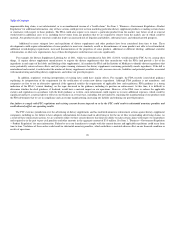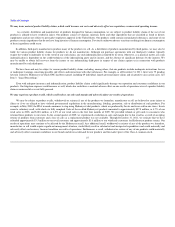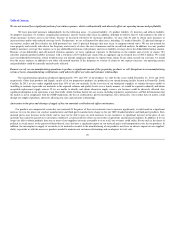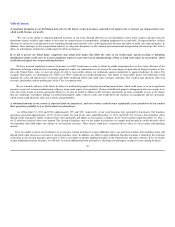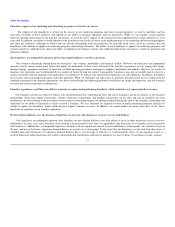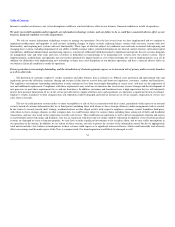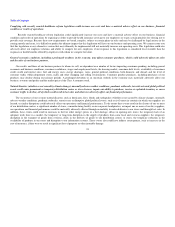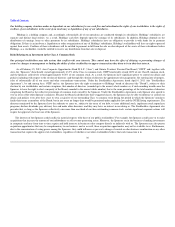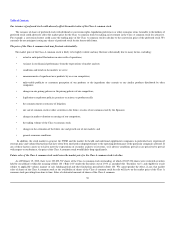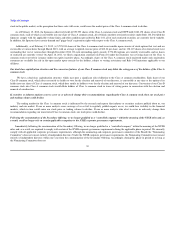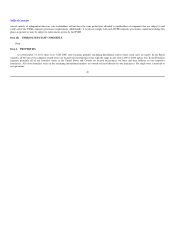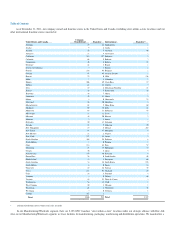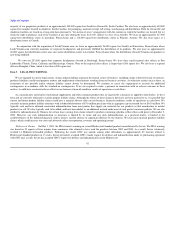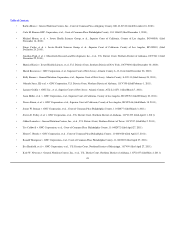GNC 2012 Annual Report Download - page 38
Download and view the complete annual report
Please find page 38 of the 2012 GNC annual report below. You can navigate through the pages in the report by either clicking on the pages listed below, or by using the keyword search tool below to find specific information within the annual report.
Table of Contents
Our holding company structure makes us dependent on our subsidiaries for our cash flow and subordinates the rights of our stockholders to the rights of
creditors of our subsidiaries in the event of an insolvency or liquidation of any of our subsidiaries.
Holdings is a holding company and, accordingly, substantially all of our operations are conducted through its subsidiaries. Holdings' subsidiaries are
separate and distinct legal entities. As a result, Holdings' cash flow depends upon the earnings of its subsidiaries. In addition, Holdings depends on the
distribution of earnings, loans or other payments by its subsidiaries. Holdings' subsidiaries have no obligation to provide it with funds for its payment
obligations. If there is an insolvency, liquidation or other reorganization of any of Holdings' subsidiaries, Holdings' stockholders will have no right to proceed
against their assets. Creditors of those subsidiaries will be entitled to payment in full from the sale or other disposal of the assets of those subsidiaries before
Holdings, as a stockholder, would be entitled to receive any distribution from that sale or disposal.
Risks Relating to an Investment in the Class A Common Stock
Our principal stockholders may take actions that conflict with your interests. This control may have the effect of delaying or preventing changes of
control or changes in management or limiting the ability of other stockholders to approve transactions they deem to be in their best interest.
As of February 15, 2012, Ares Corporate Opportunities Fund II, L.P. ("Ares") and Ontario Teachers' Pension Plan Board ("OTPP" and, together with
Ares, the "Sponsors") beneficially owned approximately 43.3% of the Class A common stock, OTPP beneficially owned 100% of our Class B common stock,
and the Sponsors collectively owned approximately 44.4% of our common stock. As a result, the Sponsors have significant power to control our affairs and
policies including with respect to the election of directors (and through the election of directors the appointment of management), the entering into of mergers,
sales of substantially all of our assets and other extraordinary transactions. Under the Stockholders Agreement, dated April 6, 2011 (the "Stockholders
Agreement"), by and among Ares, OTPP and us, the Sponsors have the right to nominate to Holdings' board of directors (the "Board"), subject to their
election by our stockholders and certain exceptions, that number of directors (rounded up to the nearest whole number or, if such rounding would cause the
Sponsors to have the right to elect a majority of the Board, rounded to the nearest whole number) that is the same percentage of the total number of directors
comprising the Board as the collective percentage of common stock owned by the Sponsors. Under the Stockholders Agreement, each Sponsor also agreed to
vote in favor of the other Sponsor's nominees. Because the Board is divided into three staggered classes, the Sponsors may be able to influence or control our
affairs and policies even after they cease to own a majority of our outstanding Class A common stock during the period in which the Sponsors' nominees
finish their terms as members of the Board, but in any event no longer than would be permitted under applicable law and the NYSE listing requirements. The
directors nominated by the Sponsors have the authority to cause us, subject to the terms of our debt, to issue additional stock, implement stock repurchase
programs, declare dividends, pay advisory fees and make other decisions, and they may have an interest in our doing so. The Stockholders Agreement also
provides that, so long as the Sponsors collectively own more than one-third of our then outstanding common stock, certain significant corporate actions will
require the approval of at least one of the Sponsors.
The interests of the Sponsors could conflict in material respects with those of our public stockholders'. For example, the Sponsors could cause us to make
acquisitions that increase the amount of our indebtedness or sell revenue-generating assets. Moreover, the Sponsors are in the business of making investments
in companies and may from time to time acquire and hold interests in businesses that compete directly or indirectly with us. The Sponsors may also pursue
acquisition opportunities that may be complementary to our business, and as a result, those acquisition opportunities may not be available to us. Furthermore,
due to the concentration of voting power among the Sponsors, they could influence or prevent a change of control or other business combination or any other
transaction that requires the approval of stockholders, regardless of whether or not other stockholders believe that such transaction is in
36


